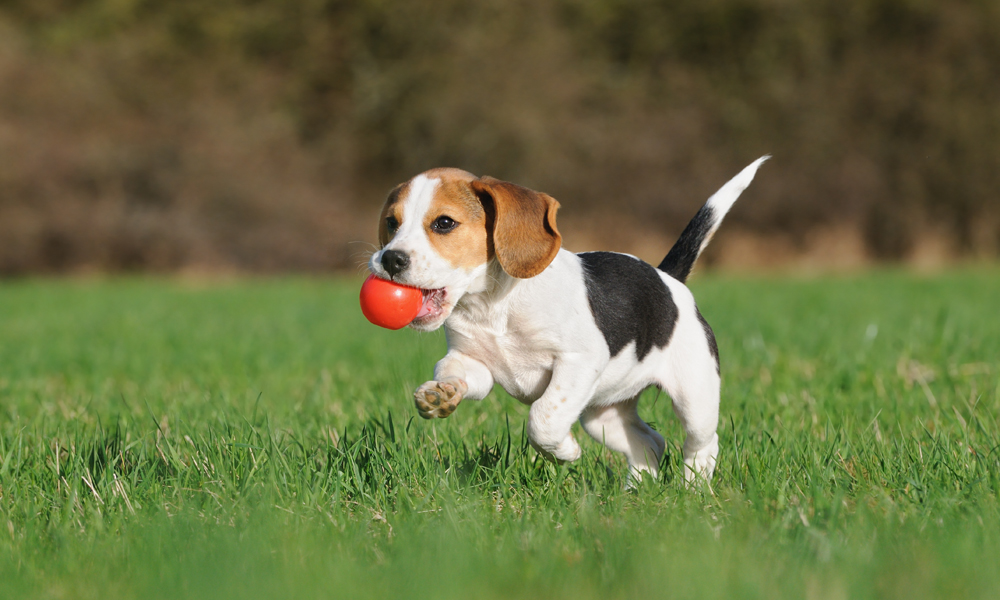Most dogs love to run and jump and play, so maintaining strong mobility is critical for their quality of life. Unfortunately, joint problems can reduce mobility and contribute to other health issues. Joint issues can affect dogs of any age or breed, and the severity and impact will vary for every individual animal. However, large dogs in particular are more likely to experience joint issues because of the extra weight they carry. Let’s explore some of the reasons why dogs develop joint problems, some common types of issues and what you can do to help your dog enjoy healthy joints for life.
Causes of joint issues in dogs
Joint issues often develop because of a combination of factors. But here are some of the most common causes of joint problems in dogs:
Developmental issues – Some dogs are just genetically predisposed to joint issues from birth. Their genetic chemistry prevents joints from developing normally, creating problems that can appear immediately or later in life. Developmental joint issues are much more common in large dog breeds such as Bernese Mountain Dogs and Rottweilers.
Degenerative issues – Ask anyone over the age of 50 and they’ll probably tell you their knees and other joints are stiffer than they used to be. Dogs are no different. As dogs age, they can develop joint problems based on their diet, growth rate, hormones, muscle mass, exercise level and their environment. Degenerative issues can actually start in puppyhood, but the signs may not be noticeable until later in life.
Injury – If a dog gets injured, it can contribute to joint issues long after the initial injury is healed. Even if an injury doesn’t seem significant at the time — no noticeable pain or trouble walking — if the cartilage was damaged, the trauma could lead to joint problems later in life.
Obesity – The heavier a dog is, the more pressure is being put on their joints. This is why obese dogs are more likely to develop joint problems, particularly as they age. Keeping dogs at the weight recommended by their veterinarian is the best way to avoid weight-related joint problems.
Common types of joint problems
There is a wide range of diseases and conditions that can negatively affect a dog’s joint health. Some of the most common types of joint problems in dogs include:
Hip dysplasia – Hip dysplasia [[HYPERLINK TO “October Blog #2: Hip dysplasia in dogs” WHEN LIVE]] is a degenerative bone disease that begins early in life, but symptoms often don’t become apparent until a dog is several years old. Hip dysplasia can be painful and severely inhibit a dog’s ability to walk. As with other types of joint problems, signs of hip dysplasia include reluctance to jump or use stairs, unsteady walking, lethargy, a change in gait and loss of muscle mass in the thighs.
Arthritis – Arthritis in dogs can take many forms, including cancerous arthritis, septic arthritis and immune-mediated arthritis. In all variations, joint pain is caused by a breakdown in the joint cartilage. Studies suggest 20% of all dogs over the age of one have some level of osteoarthritis.
Legg-Calvé-Perthes Disease – Also known as “aseptic necrosis of the femoral head,” this disease is most commonly found in small dog breeds. The condition is caused when the head of the femur bone starts to deteriorate, and over time, this can lead to arthritis or a complete collapse of the hip joint. The disease can develop quite rapidly, so it’s important for pet parents to be aware if dogs start showing signs of lameness or an inability to put weight on their hind limbs.
Osteochondrosis – This condition mainly impacts large dogs that grow quickly and happens when immature cartilage begins to separate from the bone, creating a space for fluid to enter. This creates inflammation that can lead to arthritis, and further deterioration of the cartilage can significantly impact range of motion in the affected joint. Stiffness and fluid buildup at the joint are two of the primary signs of osteochondrosis.
How pet parents can help prevent joint problems
Here are some simple things you can do to help your dog maintain healthy joints throughout their life:
Get routine health exams – Detecting joint problems early is important for mitigating the most serious health impacts. Routine health exams give veterinarians an opportunity to identify joint problems and start treatment as soon as possible. If you are concerned about joint health, talk to your veterinarian about other ways you can keep your pet feeling their best.
Get the right kind of exercise – Regular exercise helps dogs maintain a healthy weight to avoid putting too much strain on their joints. But some activities can actually be more harmful than helpful. The impact of landing after jumping can put significant strain on joints, especially for large dogs. Low-impact exercises like swimming or walking on soft ground can help keep off the pounds while still protecting joints.
Prioritize quality nutrition – A dog’s diet plays a significant role in their overall health, including joint health. Feeding your dog quality, nutritious food and supplements is one of the best ways to avoid joint problems. For example, PureVita Hip & Joint Treats by NutriSource are enhanced with glucosamine and chondroitin to help maintain cartilage levels and keep joints healthy.
Helping dogs live healthy lives
Joint pain is common in dogs, but that doesn’t mean it’s inevitable. By taking some proactive steps today, pet parents can help keep their dogs happy and healthy for years to come.
Shop local and buy NutriSource products from one of the independently owned and operated pet suppliers in your local area.


